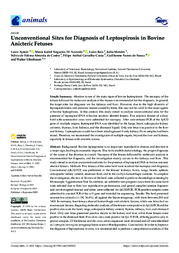Unconventional sites for diagnosis of leptospirosis in bovine anicteric fetuses.
Unconventional sites for diagnosis of leptospirosis in bovine anicteric fetuses.
Autoria: AYMÉE, L.; DI AZEVEDO, M. I. N.; REIS, L.; MENDES, J.; CASTRO, F. de D. A. de; CARVALHO-COSTA, F. A. C.; SOUZA, G. N. de; LILENBAUM, W.
Resumo: Background: Bovine leptospirosis is an important reproductive disease and abortion is a major sign, leading to economic impacts. Due to its multifactorial etiology, the proper diagnosis of the cause of the abortion is crucial. Necropsy of the fetuses followed by molecular analysis is recommended for diagnosis, and the investigation mainly occurs in the kidneys and liver. This study aimed to analyze unconventional sites for the presence of leptospiral DNA in bovine anicteric aborted fetuses. Methods: Five fetuses of the same herd were received for necropsy and diagnosis. Conventional lipL32-PCR was performed in the fetuses? kidneys, livers, lungs, hearts, spleens, subcapsular kidney content, abomasal fluid, and in the cavity?s hemorrhagic contents. To complete the investigation, the sera of 30 cows of the herd were collected to perform the serologic screening by Microscopic Agglutination Test. In addition, six subfertile non-pregnant cows from the same herd were selected due to their low reproductive performance, and genital samples (uterine fragment and cervicovaginal mucus) and urine were collected for lipL32-PCR. PCR-positive samples were submitted to a nested PCR of the secY gene and intended for sequencing. Results: The herd presented seroreactive animals (11/30, 36.6%), all against the Sejroe serogroup, with titers between 200 and 1600. In necropsy, four fetuses showed hemorrhagic and anicteric lesions, while one fetus had no macroscopic lesions. Regarding molecular analysis, all the fetuses were positive in lipL32-PCR and the positive sites were the heart, lungs, subcapsular kidney content, thymus, kidneys, liver, and abomasal fluid. Only one fetus presented positive results in the kidney and liver, while three fetuses were positive in the abomasal fluid. Five of six cows were positive for lipL32-PCR, all being positive only in genital samples. Of the fetuses and the cows, seven sequences were obtained and all were identified as Leptospira interrogans serogroup Sejroe serovar Hardjoprajitno. Conclusions: In order to improve the diagnosis of leptospirosis in cows, it is recommended to perform a comprehensive analysis of the samples, beyond the kidneys and liver. Thus, we highly encourage testing multiple organs by PCR to investigate abortions suspected of bovine leptospirosis, particularly in anicteric fetuses.
Ano de publicação: 2023
Tipo de publicação: Artigo de periódico
Unidade: Embrapa Gado de Leite
Palavras-chave: Abomasal fluid, Aborto, Bovino, Gado, Leptospiral infection, Leptospirose, LipL32, Molecular analysis
Observações
1 - Por padrão são exibidas publicações dos últimos 20 anos. Para encontrar publicações mais antigas, configure o filtro ano de publicação, colocando o ano a partir do qual você deseja encontrar publicações. O filtro está na coluna da esquerda na busca acima.
2 - Para ler algumas publicações da Embrapa (apenas as que estão em formato ePub), é necessário ter, no celular ou computador, um desses softwares gratuitos. Sistemas Android: Google Play Livros; IOS: iBooks; Windows e Linux: software Calibre.
Acesse outras publicações
Acesse a Base de Dados da Pesquisa Agropecuária (BDPA) para consultar o acervo completo das bibliotecas da Embrapa.

